 |
|
 |
| |
發行人:黃建璋所長 編輯委員:曾雪峰教授 主編:林筱文 發行日期:2021.04.30 |
| |
|
 |
|
本所5、6月份演講公告:
| 日期 |
講者 |
講題 |
地點 |
時間 |
|
5/7 |
孫慶成講座教授
國立中央大學光電系
2020年中華民國光電學會理事長 |
光學新視界 |
博理館 101演講廳 |
14:20~16:00 |
|
5/14 |
蔡富吉執行長
Chief executive officer, 澔心科技股份有限公司 |
待訂 |
博理館 101演講廳 |
14:20~16:00 |
|
5/21 |
陳階曉執行長
鈦隼生物科技股份有限公司 |
Start-up
Company and Our Robotic Application |
博理館 101演講廳 |
14:20~16:00 |
|
5/28 |
張鼎張講座教授
國立中山大學物理系 |
低溫缺陷鈍化技術在半導體元件應用 |
博理館 101演講廳
|
14:20~16:00 |
|
6/11 |
瑞鼎科技股份有限公司 |
待訂 |
博理館 101演講廳 |
14:20~16:00 |
|
|
 |
|
 |
|
| |
|
 |
|
3月份「光電所專題演講」(整理:姚力琪) |
|
時間: |
110年3月12日(星期五)下午2時20分 |
|
講者: |
劉致為特聘教授(國立臺灣大學光電所) |
|
講題: |
3Dx3Dx3D: Moore's Law continuing |
|
 |
|
本場演講者劉致為特聘教授 |
|
|
時間: |
110年3月19日(星期五)下午2時20分 |
|
講者: |
吳志凌副處長(錼創科技先進技術開發處) |
|
講題: |
PlayNitride MicroLED Display - PixeLED® Display Technology |
|
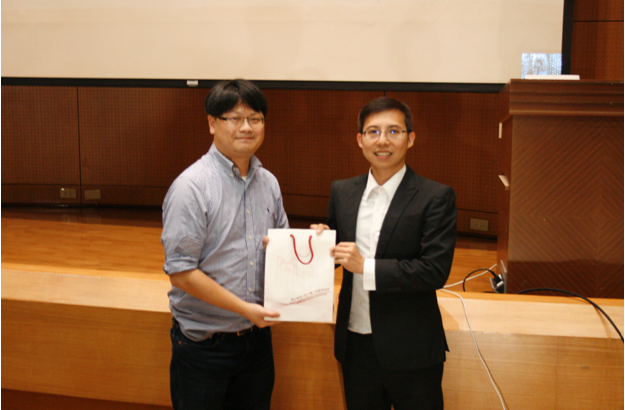 |
|
吳志凌副處長(右)與本所李翔傑教授(左)合影 |
|
|
時間: |
110年3月26日(星期五)下午2時20分 |
|
講者: |
李正匡博士(NVIDIA AI Technology Center) |
|
講題: |
Accelerating AI and HPC – NVIDIA computing platform |
|
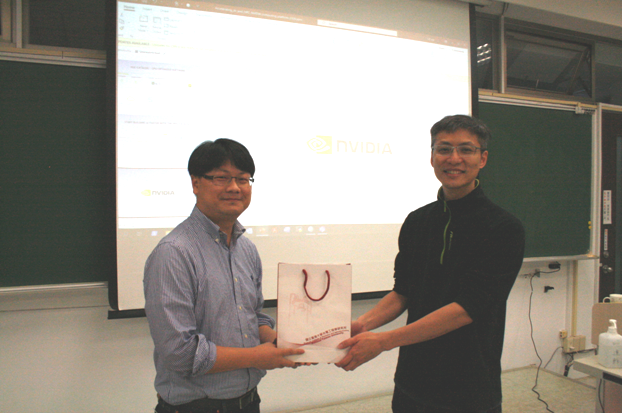 |
|
李正匡博士(右)與本所李翔傑教授(左)合影 |
|
|
4月份「光電所專題演講」(整理:姚力琪) |
|
時間: |
110年4月16日(星期五)下午2時20分 |
|
講者: |
徐茂傑博士(Luxnet 華星光通技術長) |
|
講題: |
半導體雷射在光通應用的發展趨勢 |
|
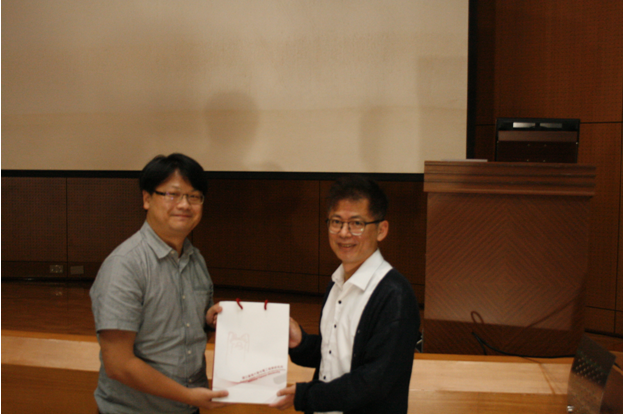 |
|
徐茂傑博士(右)與本所李翔傑教授(左)合影 |
|
|
時間: |
110年4月23日(星期五)下午2時20分 |
|
講者: |
林貞宏博士(佳世達科技股份有限公司) |
|
講題: |
科技/藝術&設計/優化,從光學開始的奇幻旅程 |
|
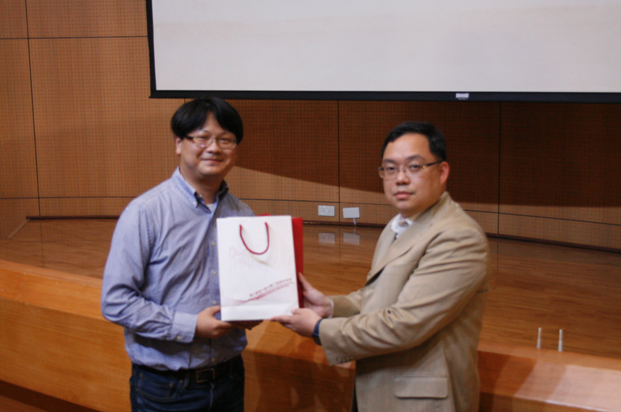 |
|
林貞宏博士(右)與本所李翔傑教授(左)合影 |
|
|
|
|
 |
|
 |
|
| |
|
 |
Characterizations of Protein-Ligand Reaction Kinetics by Transistor-Microfluidic Integrated Sensors
Professor Jian-Jang Huang’s Lab
Graduate Institute of Photonics and
Optoelectronics, National Taiwan University
臺灣大學光電所 黃建璋教授
Understanding the binding affinities and kinetics of protein-ligand interactions using a label-free method is crucial for identifying therapeutic candidates in clinical diagnostics and drug development. In this work, the IGZO-TFT (thin-film transistor) biosensor integrated with a tailored microfluidic chip was developed to explore binding kinetics of protein-ligand biochemical interactions in the real-time manner. The IGZO-TFT sensor extracts the binding characteristics through sensing biomolecules by their electrical charges. Using lysozyme and tri-N-acetyl-D-glucosamine (NAG3) as an example, we established a procedure to obtain the parameters, such as the dissociation constant, Kd, and association rate constant, ka, that are critical to biochemical reactions. The correlation between the lysozyme concentration and TFT drain current signal was first constructed. Next, solutions of lysozyme and NAG3 of different mixing ratios were prepared. They were pre-mixed for various periods of reaction time before applying to the TFT sensor to extract signals of lysozyme molecules and the concentration remaining. With the knowledge of drain current changes at different reaction times, ka and Kd can be obtained. The values from our experiment are comparable to other methods, which suggests the proposed approach can be employed to explore protein-ligand interaction kinetics in the massively parallel manner if the TFT array is considered.
|

|
|
Fig. 1. (a) Schematic diagram of the IGZO-TFT biosensor integrated with a microfluidic channel. (b) Cross sectional view of the staggered and double-gated TFT. |
|
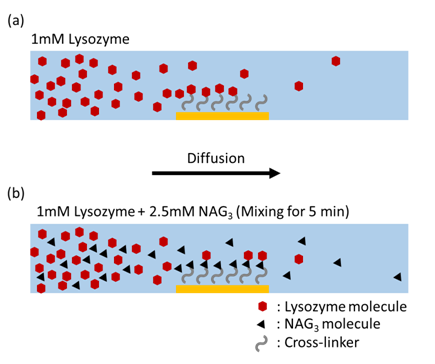
|
|
Fig. 2 Illustration of molecule capture process of (a) Lysozyme solution (b) lysozyme + NAG3 solution. Note that in addition to the screening effect, with the presence of NAG3, the drain current will be increased instead of decreased as opposed to the case of purelysozyme solution. |
Flexible Complementary Oxide Thin-Film Transistor-Based Inverter
with High Gain
Professor I-Chun Cheng
Graduate Institute of Photonics and
Optoelectronics, National Taiwan University
臺灣大學光電所
陳奕君教授
Wearable bio-sensing devices are considered promising for ubiquitous heath monitoring. To accurately read out small bio-signals, the development of high-performance flexible front-end circuits is crucial. Oxide semiconductors are considered one of the most promising active channel materials for on-polymeric-foil electronics. So far, most flexible complementary TFT inverters have been based on either pseudo-CMOS or organic-inorganic hybrid-CMOS configurations. In this study, a high-gain flexible CMOS inverter with a beta ratio (width-to-length ratio between the pull-up and pull-down transistors) of 1 was demonstrated by monolithically integrating a top-gated n-type IGZO TFT and a bottom-gated p-type SnO TFT on a 5.5-μm-thick polyimide substrate, as shown in Figure 1. The IGZO TFT exhibits a field-effect mobility of 8.0 cm2V-1s-1, threshold voltage of 5.2 V, subthreshold swing of 0.15 V/decade, and high on/off current ratio of >107. The corresponding values for the SnO TFT are 1.6 cm2V-1s-1, 2.8 V, 2.3 V/decade and >103, respectively. No apparent current crowding is observed in the output characteristics, suggesting that ohmic contacts exist between the source/drain electrodes and the channel layers. The flexible inverter exhibited a high static voltage gain of 370 V/V and balanced noise margins (noise margin high of 4.8 V, noise margin low of 4.7 V) for a supply voltage of 10 V, as shown in Figure 2(a). In addition, as shown in Figure 2(b), the voltage transfer characteristics remained virtually unchanged when the device was subjected to an outward or an inward bending radius of 2.5 mm, indicating the complementary oxide-TFT-based inverter is practical for flexible electronics applications. [IEEE Trans. Electron Devices, vol. 68, No. 3, p. 1070, Mar 2021]
|

|
|
Fig. 1 (a) Schematic cross section of a flexible oxide-TFT-based CMOS inverter. (b) Photograph of flexible CMOS inverters fabricated on an ultrathin polyimide substrate. |
|
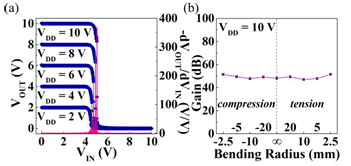
|
|
Fig. 2 (a) Voltage transfer characteristics of a flexible CMOS inverter with a beta ratio of 1 at different VDD. (b) Static voltage gain of the flexible CMOS inverter under different bending conditions. |
|
 |
| |
|
|
|
 |
|
| |
|
 |
論文題目:近紅外寬頻之單模晶體光纖光源研究
姓名:楊騰毅 指導教授:黃升龍教授
| 摘要 |
|
本論文兩大主軸,一主軸為研發Cr4+:Y2SiO5做為近紅外寬頻晶纖光纖雷射材料,另外一個主軸為使用固態單晶生長纖衣法做成單模態晶體光纖雷射。過程中有觀察到Cr4+:Y2SiO5的旋節分解。在每分鐘30公釐生長速度,旋節分解面積比例會降低到0.4%。使用硼矽酸鹽玻璃作為纖衣,半高寬頻譜可以達到246 奈米,中心波長為1257奈米,相較於Cr4+:YAG中心波長1380奈米,這樣放光波段因避開水吸收,且降低散射,而提高穿透深度,所以非常適合作為光學同調斷層掃描術光源。估算縱向解析度在自由空間中為 2.8微米,而其在生物組織內約為2微米。
本論文另外一主軸為Ti:Al2O3單模態晶體光纖生長和特性檢測,使用浸塗法和攝氏1750度高溫燒結來生長纖衣。觀察到在單晶纖心周圍有固態單晶生長產生,而纖衣在沿著(01 ̅1)生長為2.7倍於(001)生長方向。使用背向散射電子繞射技術和電子顯微鏡可以確定其為單晶結構。在光學量測中,使用穿透光的遠場分佈跟單模光場分佈吻合,如圖一所示,可以證實其為單模態晶體光纖。使用的纖心為30微米直徑,折射差為1.0 x 10-4。在螢光頻譜在端面量測裡,可以觀察到三價鈦離子良好的侷限於纖心於單晶纖衣生長過程,如圖二所示。
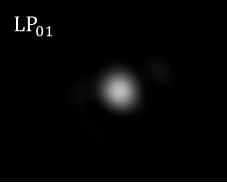 |
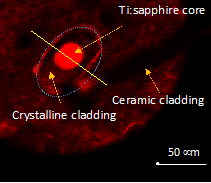 |
|
圖一、穿透光遠場圖 |
圖二、端面螢光影像 |
|
|
 |
|
 |
|
| |
|
 |
—
資料提供:影像顯示科技知識平台 (DTKP, Display Technology
Knowledge Platform) —
—
整理:林晃巖教授、卓真禾 —
原子尺度的波形採樣
原子尺度與超快速時間標度的物質操縱會發生在重要過程中,例如電子轉移,分子運動和化學反應等。這些時空動力學的可視化是科學界的長期目標。近年來,場驅動奈米影像技術是奈米光子學的一個新興領域,它為研究具有極高時空解析度的光-物質相互作用的非微擾機制開闢了新途徑。由於這種光-物質交互作用不僅對電場的幅度而且對相位都敏感,因此精確控制超短雷射脈衝的載波包相位(carrier-envelope phase, CEP)極為重要。
雷射技術的最新進展使高精度超短雷射脈衝的CEP控制達成可能,並且使用這種脈衝,許多研究成功地證明了在各種定制的奈米結構中電子的超快速相干控制1,2。在這種情況下,透過將持續時間只有幾個光學週期的雷射脈衝耦合到奈米結構,電場就被限制在超過光學繞射極限的奈米尺度上,而增強的場可以在次波長尺度和超快時間標度內探索光與物質的相互作用。
結果,光驅動的掃描穿隧顯微鏡(scanning tunnelling microscopy, STM)使得探索次分子解析度的光-物質交互作用成為可能3–6。特別是,太赫茲場驅動的STM(THz-STM)4已用於追蹤奈米級的載子動力學4,5和分子運動6。透過調整單週期太赫茲脈衝的CEP,太赫茲近場波形可以在單個隧道接點處同調地誘導電子穿隧,從探針探針尖端到樣品,或反之亦然7。在這些實驗中,使用電光採樣來評估接點處的THz近場波形。但是,由於太赫茲近場的形狀與太赫茲遠場的形狀完全不同8,因此非常需要在實際的直接測量中取得太赫茲近場波形。為此,已經提出了幾種方法,例如使用太赫茲相位調整器9和光子輔助隧穿10 。儘管這些技術對於在掃描穿隧顯微鏡的尖端與樣本配置中以表徵CEP和近場波形很有用,但是在原子尺度上仍未實現無參數方法來定量評估電磁近場波形,這對於超快奈米科學和奈米電子學的進一步發展必不可少。
現在,多米尼克•佩勒(Dominik Peller)和同事在《自然光子學》(Nature Photonics)上發表了一篇文章,該方法利用單分子轉換定量評估光驅動STM中無任何自由參數的原子級電磁波形11。在該方案中,太赫茲遠場聚焦在尖端與樣本交界處,從而產生了增強了幾個數量級的場。為了以原子尺度解析度定量評估實際的太赫茲波形,作者將單個分子的酞菁鎂(MgPc)引入了隧道間隙。
眾所皆知,僅當從局部電場E(t)導出的電壓V(t)超過臨界閾值時,吸附在銅基板上的氯化鈉上的酞菁鎂(MgPc)的單個分子才能在兩個等效幾何形狀之間來回切換12。如圖1a所示,這種切換機制可作為原子級電壓探針。請注意,即使在極弱的穿隧條件下,具有低重複頻率的雷射脈衝,該單分子的切換統計數據也會發生,並且它適合作為靈敏測量來繪製光驅動STM中的局部場。
為了確保超快的時間解析度,使用了由麥克森干涉儀生成的兩個相同的具有延遲時間τ的THz波形對:弱測試波形VNF(t)和延遲的強閘門波形Vgate(t –τ)。藉由干擾相對於延遲時間在近場中的這兩個波形,總電壓Vpeak(τ)的峰值可以跟追蹤瞬時波形VNF。當尖端限制的峰值電壓Vpeak達到〜1.2 V,其中峰值場進入酞菁鎂(MgPc)的最低未佔分子軌域(LUMO)時,電子穿隧在統計學上會激發翻轉事件,然後記錄每個雷射光發射的切換速率p與峰值電壓Vpeak的關係。由於LUMO狀態的穿隧共振的線寬變寬,因此峰值電壓的不同值會引起不同的穿隧速率。如圖1b所示,切換速率p隨著峰值電壓的增加而立即增加,然後達到飽和,其開始行為很容易給出相對於尖端限制的峰值電壓Vpeak的p校準曲線;也就是說,導數dp / dVpeak表示透過穩態STM測量的差分電導dI / dV的類比。因此,透過將dp / dVpeak數據(灰色,圖1b)與通過穩態STM(藍色,圖1b)獲得的共振曲線進行比較,尖端限制的峰值電壓Vpeak可以以伏特為單位直接獲得,沒有任何自由參數。隨後,透過利用反向的起始曲線Vpeak(p),可以在通道接點兩端實現局部峰值電壓的恢復。
透過根據VNF(t)和Vgate(t –τ)之間的延遲時間τ測量切換速率p,可以提取出疊加波形的峰值電壓Vpeak(τ),並且可以得出目標波形VNF(t)是用飛秒時間和原子空間分辨率獲得的。檢測到的電壓波形如圖1c所示。檢測到的波形類似於通過電光採樣對入射遠場波形進行的測量。然而,觀察到兩個波形之間的相位和總線形上的差異,這表明地確定近場波形的重要性。注意,原位方法可以在沒有任何自由參數的情況下找回局部場波形,因此適用於各種系統,而與尖端採樣條件無關。
為了全面了解所獲得的局部場波形,基於經典電動力學和依時密度函數理論(time-dependent density functional theory, TDDFT)的基礎上進行了兩次模擬。在經典電動力學模擬的情況下,透過用有限元素計算求解馬克士威方程組來計算場傳播,然後獲得尖端限制電壓波形。結果,透過比較測得的波形(數據點,圖1c)和計算的波形(實線,圖1c)可以看出,透過模擬可以很好地再現觀察到的波形的總體特徵。另一方面,用或不用酞菁鎂(MgPc)分子建模的TDDFT計算揭示了超快穿隧過程的量子力學描述的重要性,該過程在時空上改變了局部場。然而,在每個脈衝只有不到一個電子穿隧電位障壁的情況下,穿隧過程不會干擾電壓瞬變,從而導致測量波形和經典計算波形之間的一致性,如圖1c所示。但是,當每個脈衝有多個電子穿隧電位障壁時,作者預測應考慮穿隧過程的量子力學動力學。
|
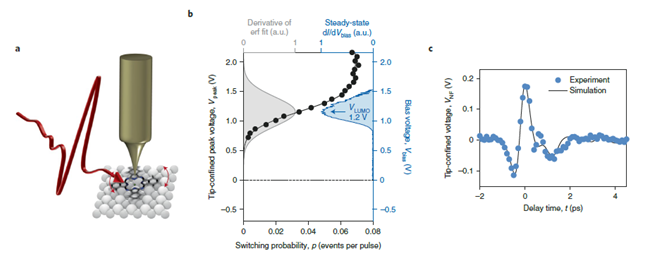
|
|
圖1、近場波形採樣。(a)引入光波驅動的STM中的單分子轉換的示意圖。(b)由尖端限制的峰值電壓引起的轉換機率p。峰值電壓的不同值導致不同的穿隧速率,並且其起始行為給出了作為Vpeak函數的p的校準。(c)檢測到的尖端限制電壓波形的實驗數據,與基於經典電動力學的模擬顯示出很好的一致性。面板b,c經參考文獻11(施普林格•自然公司Springer Nature Ltd.)許可改編。 |
總之,Dominik Peller及其同事的工作展示了使用單分子轉換執行原子尺度的電磁波形採樣的能力。由於切換事件統計地發生在峰值電壓達到分子共振時,並且無需任何自由參數即可輕鬆獲取局部波形,因此該方法成為光波驅動STM中原位測量的強大工具。基於TDDFT計算的量子力學穿隧過程的全面研究,對於理解原子尺度的光-物質相互作用也有很大的幫助13。因此,這裡提出的概念不僅在場驅動顯微鏡中具有根本的重要性,而且對於探索超快原子尺度電子學也至關重要。
|
參考資料: |
Jun Takeda & Ikufumi Katayama, “Waveform sampling on an atomic scale,”
Nature Photonics volume
15, 70-71(2021)
https://doi.org/10.1038/s41566-020-00753-z
DOI: s41566-020-00753-z
|
|
參考文獻: |
1. Corkum, P. B. & Krausz, F.
Nat. Phys. 3, 381–387 (2007).
2. Dombi, P. et al. Rev. Mod.
Phys. 92, 025003 (2020).
3. Garg, M. & Kern, K.
Science 367, 411–415 (2020).
4. Cocker, T. L. et al.
Nat. Photon. 7, 620–625 (2013).
5. Jelic, V. et al. Nat. Phys. 13, 591–598 (2017).
6. Cocker, T. L., Peller, D., Yu, P., Repp, J. & Huber, R.
Nature 539,
263–267 (2016).
7. Yoshioka, K. et al. Nat. Photon. 10, 762–765 (2016).
8. Wang, K., Mittleman, D. M., van der Valk, N. C. J. & Planken, P.
C. M. Appl. Phys. Lett. 85, 2715–2717 (2004).
9. Yoshioka, K. et al. Nano Lett.
18, 5198–5204 (2018).
10. Yoshida, S. et al. ACS Photon.
6, 1356–1364 (2019).
11. Peller, D. et al. Nat. Photon. https://doi.org/10.1038/s41566-020-
00720-8 (2020).
12. Peller, D. et al. Nature
585, 58–62 (2020).
13.
Jestädt, R., Ruggenthaler, M.,
Oliveira, M. J. T., Rubio, A. &
Appel, H. Adv. Phys.
68, 225–333 (2019).
|
|
|
|
|
|
 |
|
|
|
|
|
|
|
|
|
|
|
 |
|
|
|
 |
|
 |
|